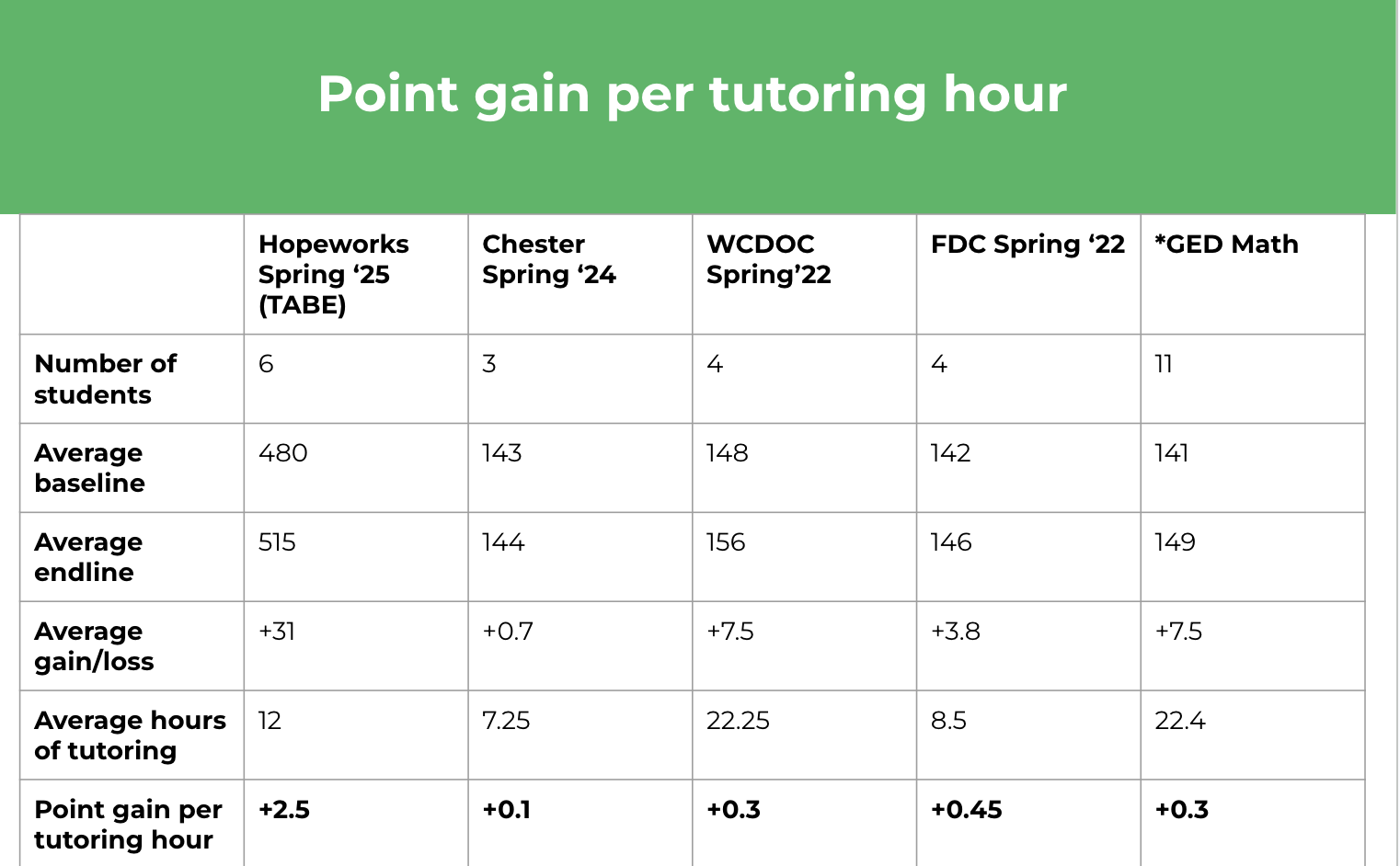Preliminary Analysis Confirms, Tutoring Boosts Academic Success
Individualized, holistic educational support programs are essential components of high quality education. Tutoring, in particular, is among the most effective education interventions to be subjected to rigorous evaluation: it has been demonstrated to boost attendance, engagement, and academic success, especially for first generation and marginalized students (Kraft and Falken, 2020, Dietrichson et al., 2017; Nickow et al., 2020; Colver and Fry 2016; Reinheimer and McKenzie, 2011).
Building on this research, colleges and high schools across the country have long offered robust tutoring programs, which have become a key feature of the student experience. But what about incarcerated and formerly incarcerated students? That’s a different story. Education in carceral and reentry settings rarely includes tutoring and has even been identified by students as a crucial need (Meyer et al (2010). There is also a dearth of research on how to apply long-standing best practices from traditional campuses to carceral classrooms. The Puttkammer Center for Educational Justice and the Petey Greene Program are tackling this gap in both research and practice, offering high quality tutoring to more than 2,000 students each year and evaluating its impact on learners’ confidence and academic progress.
A classroom with tutors from the Petey Greene Program working with students
Classrooms inside prisons and jails are often composed of individuals at different grade levels, with varied learning goals, strengths, and backgrounds. These students especially benefit from individualized support – and we have the data to prove it (Fizer 2020, Davis, 2001, Tewsbury and Stengel, 2006, Knowles, 1980, TEAL Center, 2011). A decade ago, a quasi-experimental study showed that students tutored by the Petey Greene Program advanced two grade levels more than non-tutored students over the course of just one semester, with statistical significance. Over the past two years, the Puttkammer Center for Educational Justice has collected qualitative and quantitative data that confirm and update these findings.
Student surveys repeatedly show that the PGP creates a safe learning environment that encourages both academic growth and confidence. 83% of participating students in our spring ‘25 survey reported making progress towards their academic goals through tutoring, and 80% felt comfortable to make mistakes during their sessions. 89% of students say that they are more confident in achieving the goals they set for themselves because of the PGP’s programming.
A more comprehensive analysis of student GED scores offers insights into the quantitative gains students are making. Alongside our existing anecdotal and survey data, this analysis helps to paint a clearer picture of how students grow over the course of the PGP’s programming.
We analyzed HSE standardized testing data from 44 unique students across four of our programs from the spring of 2021 through spring 2025. While this group is smaller than what we would need for a rigorous analysis and we were not able to rule out the influence of other factors on students’ scores, this preliminary examination will help guide us as we continue to gather more student data and build towards creating a robust and representative sample. It also gives our regional staff an idea of what our students’ educational journeys can look like in one semester of tutoring, helping both our staff and partners better structure learning plans and estimate how many hours of tutoring may be needed for our students to successfully pass their GED exam.
Analysis suggests that students improve approximately 3 GED points per semester through the PGP’s tutoring programs, at a rate of roughly 0.3 points per tutoring hour. This may not sound like much, but when we consider that a passing score on the GED is 145 and that our students have average baseline scores in the 140s when they first begin tutoring, a few points can mean the difference between retaking the test or achieving their GED at last. It also suggests students who begin tutoring with a baseline of 140 or higher are likely to pass their GED section in a single semester, while those scoring below 140 may need additional hours beyond our standard number of tutoring hours in order to also pass within one semester. Having this approximation of the rate will help our tutors and staff give students more concrete steps to success.
While the programs we analyzed differed in terms of total hours each student received, we did find a consistent average point gain per tutoring hour across both programs and subjects, suggesting that the key to student success may lie in increased access.
The program where we saw the most significant gains was in our blended learning program which the PGP served as the primary provider, rather than supplementary support. As a result, this program had many more hours of programming compared to the others in the sample. It is a demonstration of what students can achieve in a short period of time with intensive instruction, when given access to quality education. In the context of education in carceral spaces, time is a precious commodity due to limited classroom space, other elective and mandated programming, delays or cancellations due to security concerns, and other factors that may reduce the time our tutors have to work with our students. However, the findings suggest that when we are able to invest significantly in our students, we see considerable gains!


